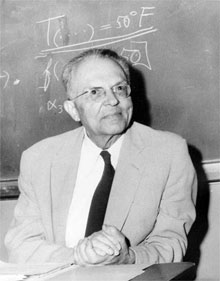
Carnap
Rudolf Carnap (May 18, 1891 – September 14, 1970) was a key figure of the Vienna Circle and the most important of the logical empiricists. His key conviction, maintained throughout his life, was that metaphysical disputes were without cognitive content. Philosophy was to contribute to the sciences. Progress was to be achieved through the use of formal logical method. Its virtue, according to Carnap, was not only that thereby metaphysical statements could be recognized as meaningless, but that other, distinctively philosophical confusions could be solved or avoided by distinguishing those statements whose truth followed from the linguistic framework in which they were embedded – analytic truths –from those stating matters of fact – synthetic truths.
In these respects Carnap followed Kant and Wittgenstein; he had earlier attended Frege’s classes on formal logic at the University of Jena. Russell was also a key inspiration. Having spent the year 1917-18 studying physics at the University of Berlin, in the year Einstein was appointed, he returned to Jena to write a doctoral thesis presenting an axiomatic system of space and time. The axiomatic method, whether employed in physical or purely mathematical theories, had had notable successes in Russell’s work; it was also championed by Hilbert. Carnap set out, in The Logical Construction of the World, to provide just such an axiomatisation, not of a physical theory, but of the structure of subjective perception, so as to derive by logical consequence a system of sentences formally equivalent to sentences about physical objects in space and time. His aim was to demonstrate that realists and idealists do not differ on any matter of fact, but only on the form of language they employ.
In subsequent schematic formalizations of the language of science Carnap, along with others of the Vienna Circle, were forced to the conclusion that a strict demarcation between meaningful and meaningless (and in particular metaphysical) discourse could not be sustained, at least at the level of individual sentences, but it was still thought that theories as wholes – or as ‘partially-interpreted formal systems’ could be distinguished in this way. With this, in the analysis, for example, of dispositional terms, the goal of explicit definition was abandoned. This marked the difference between ‘logical positivism’ and ‘logical empiricism’, as announced by Carnap in ‘Testability and Meaning’ (1934). In his masterpiece of formal method, The Logical Syntax of Language, in which Carnap sought to resolve disputes in the philosophy of mathematics by showing them reducible to differences in strengths of logical systems, Carnap acknowledged Duhem’s thesis of holism, according to which it is the combination of several scientific theories, not of any one theory taken in isolation, which is empirically meaningful. But as Quine famously argued, in ‘Two Dogmas of Empiricism’ (1949), the result is that the only plausible empiricist desiderata sustaining the analytic-synthetic distinction as a doctrine about individual sentences was fatally undermined.
If Carnap’s philosophy was attacked by Quine, it gained qualified support from Kuhn’s notion of scientific paradigm (to be compared to Carnap’s notion of linguistic framework). Kuhn’s arguments for the incommensurability of scientific theories allied to different paradigms, in times of revolutionary theory change, were based on the historical evidence. Although Carnap’s philosophy was supposedly concerned with rational reconstruction rather than the actual history of scientific discovery, that it shared similar characteristics to Kuhn’s theory of scientific change has greatly strengthened it.
Carnap was born in Wuppertal, Germany, and went to school at the Gymnasium in Barmen. He attended university at Jena and Berlin. Moritz Schlick offered him a position at the University of Vienna in 1926, where a group of philosophers, scientists and economists came together on a weekly basis. This, the Vienna Circle, included the physicist Philipp Frank, the social scientist Otto Neurath, the mathematician Olga Hahn-Neurath, the philosopher Viktor Kraft, the mathematicians Theodor Radacovic and Gustav Bergmann. It also included Schlick’s students, notably Friedrich Waismann, Herbert Feigl and Marcel Natkin, and among Hahn's students, Karl Menger and Kurt Gödel. There were also frequent visitors: Hans Reichenbach and Kurt Grelling among them. Carl Hempel from Berlin, A. J. Ayer from England, Alfred Tarski from Poland, W.V. Quine from the U.S.A. also visited. Karl Popper and Ludwig Wittgenstein met with Schlick and other members of the Vienna Circle, but never considered themselves allied to it.
The Vienna Circle was effectively dissolved with the Anschluss in 1936 and the murder of Schlick by a disaffected student that same year. Carnap left Vienna for a position at the University of Prague in 1931 and, following the rise to power of Nazism, at the University of Chicago in 1936. He became a naturalised U.S. citizen in 1941. He became Professor of Philosophy at UCLA, taking Reichenbach’s position, in 1954.
Links
Stanford Encylopaedia of Philosophy: Logical Empiricism >
